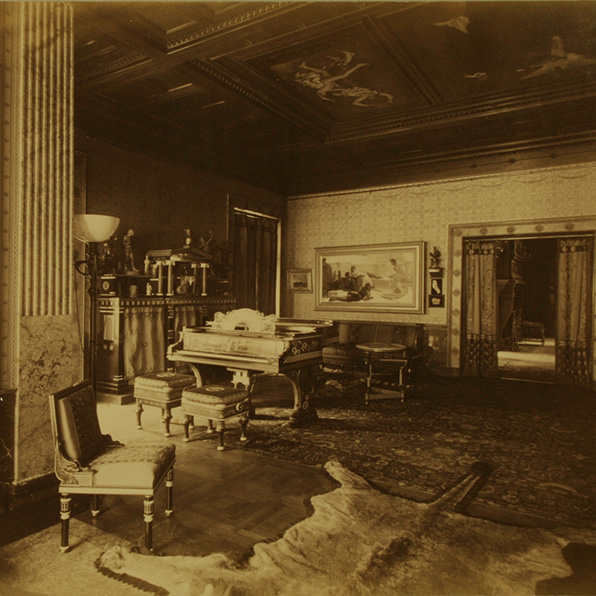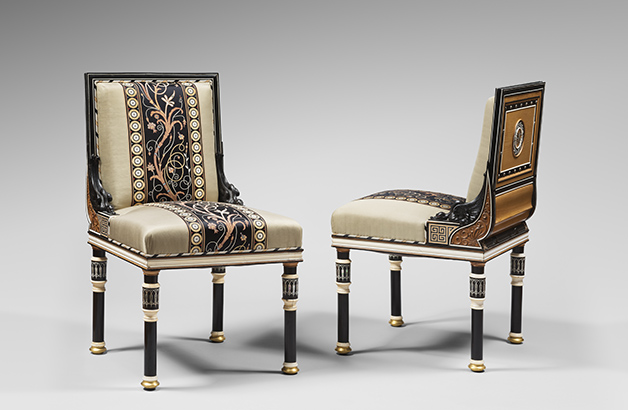
JUNE 4–SEPTEMBER 4, 2017
THE MAKING OF THE MARQUAND MUSIC ROOM
Attributed to George Collins Cox (American, 1851–1902)
Marquand Music Room: view of the room and ceiling from the alcove, c. 1888–90
Albumen print mounted on mat board, stamped: G. C. Cox Photo
Nassau County Department of Parks, Recreation, and Museums, Photo Archives Center
Henry Gurdon Marquand’s mansion at 68th Street and Madison Avenue in New York was designed by noted architect Richard Morris Hunt (American, 1827–1895) and built between 1881 and 1884. Marquand employed many leading artists and design firms to create rooms in different styles, including an English Renaissance dining room, a Japanese living room, a Moorish smoking room, and a Greco-Pompeiian music room. Marquand was an avid supporter of musical performances and an important collector of art, and the music room reflected those interests. Marquand was probably thinking about Alma-Tadema’s deep knowledge of antiquity and his success in designing his own homes when he turned to the London-based painter to design the music room. In turn, Alma-Tadema enlisted an expert furniture firm and several artist friends to bring his vision for the room to fruition. The two most famous rooms in the house—the Japanese living room and the music room—were hailed as “unrivaled in their originality,” and the contributions of Alma-Tadema, Johnstone, Norman & Co., Edward Poynter, and Frederic Leighton all drew extravagant praise. The exhibition explores Marquand’s background, Alma-Tadema’s approach to creating designs for the room, the history of the firm that fabricated the furniture, and the contributions of Edward Poynter and Frederic Leighton to the finished room.
Sir Lawrence Alma-Tadema, designer (British, born Netherlands, 1836–1912)
Johnstone, Norman & Co., London, manufacturers
Two Occasional Chairs, 1884–85
Ebony, cedar, boxwood, ivory, mother-of-pearl, abalone, brass, glass and red foil, and modern upholstery
Mugrabi Collection
Image © J. Beylard and V. Luc – Agence Phar, Paris
Orchestrating Elegance reunites many of the original components of the music room for the first time since Marquand’s death. In addition to twelve pieces of the original furniture suite, the two Alma-Tadema paintings that hung in the room are on view, along with several examples of ancient ceramics from Marquand’s collection and versions of two bronze sculptures Marquand acquired to decorate the room. Over the years, all of the furniture has lost its original upholstery. Museums and collectors have taken different approaches in recreating the original appearance of these textiles. Two door curtains (known as portieres) were donated to the Clark in 2015; the portieres were conserved and mounted and are displayed alongside the furniture. By bringing together many of the original components of the room, the exhibition offers an evocative glimpse into one of the most extraordinary interiors of New York’s Gilded Age.
A fully illustrated catalogue, edited by Kathleen M. Morris and Alexis Goodin with contributions by Kathleen M. Morris, Alexis Goodin, Melody Barnett Deusner, and Hugh Glover, accompanies the exhibition. This beautiful publication documents and examines the celebrated design of an elaborate music room for financier, art collector, and philanthropist Henry Gurdon Marquand by eminent British painter Sir Lawrence Alma-Tadema. The catalogue is published by the Clark and distributed by Yale University Press. Call the Museum Store at 413 458 0520 to order.



